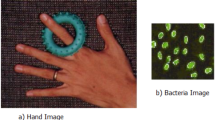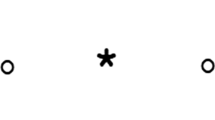Abstract
Multimodal medical imaging (MMI) volumes can be derived by spatial correlating intensity distributions from a number of different diagnostic volumes with complementary information. An unsupervised approach to MMI volumes segmentation is recommended by many authors. Due to complexity of the data structure, this kind of segmentation is a very challenging task, whose main step is clustering in a multidimensional feature space. The partial volume effect originated by the relatively low resolution of sensors produces borders not strictly defined between tissues. Therefore memberships of voxels in boundary regions are intrinsically fuzzy and computer assisted unsupervised fuzzy clustering methods turn out to be particularly suited to handle the segmentation problem. In this paper a number of clustering methods (HCM, FCM, MEP-FC, PNFCM) have been applied to this task and results have been compared.
Access this chapter
Tax calculation will be finalised at checkout
Purchases are for personal use only
Preview
Unable to display preview. Download preview PDF.
Similar content being viewed by others
References
A.M. Bensaid, L.O. Hall, L.P. Clarke, and R.P. Velthuizen (1991): MRI segmentation using supervised and unsupervised methods. In: Proc. 13th IEEE Eng. Merl Biol. Conf, Orlando. TEFE, pp.483–489.
J.C. Bezdek (1981): Pattern Recognition with Fuzzy Objective Function Algorithms, Plenum Press, New York.
J.C. Bezdek, L.O. Hall, and L.P. Clarke. Review of MR image segmentation techniques using pattern recognition, Med Phys., 20 (1993), pp. 1033–1048.
R.O. Duda and P.E. Hart (1973): Pattern Classification and Scene Analysis, Wiley, New York.
F. Firenze and P. Morasso (1993): The capture effect model: a new approach to self-organized clustering. In: Sixth International Conference. Neural Networks and their Industrial and Cognitive Applications. NEURO-NIMES 93. Conference Proceedings and Exhibition Catalog,, Nimes, France. pp. 6554.
F. Firenze, A. Schenone, F. Acquarone, M. Gambaro, F. Masulli (1995): An “adaptive resolution” analysis of multivariate medical images via unsupervised neural network based clustering. Proc. EUFIT 95, Aachen,, pp. 1690–1694.
R. Krishnapuram and J.M. Keller (1993): A possibilistic approach to clustering IEEE Transactions on Fuzzy Systems, 1: pp. 98–110.
R. Krishnapuram and J.M. Keller (1996): The Possibilistic C-Means Algorithm: insights and recommandations, IEEE Transactions on Fuzzy Systems, 4: pp. 385–393.
E.T. Jaynes (1957): Information theory and statistical mechanics, Physical Review 106, pp. 620–630.
M.N. Maisey et al. (1992): Synergistic Imaging, Eur. J. Nucl. Med, 19, pp. 1002–1005.
F. Masulli, P. Bogus, A. Schenone, and M. Artuso (1997): Fuzzy clustering methods for the segmentation of multivariate images. In M. Mares, R Mesia, V. Novak, J. Ramik, and A. Stupnanova, (editors), Proceedings of the 7th International Fuzzy Systems Association World Congress IFSA’97, volume III, Prague, Academia, pp. 123–128.
F. Masulli, and A. Schenone. A fuzzy clustering based segmentation system as support to diagnosis in medical imaging. Artificial Intelligence in Medicine,1998 (in press).
K. Rose, E. Gurewitz, and G. Fox (1993): A deterministic annealing approach to clustering, Pattern Recognition Letters, 11: 589–594, 1990.
K. Rose, E. Gurewitz, and G. Fox. Constrained clustering as an optimization method, IEEE Transactions on Pattern Analysis and Machine Intelligence, 15:pp. 785–794.
Schenone, F. Firenze, F. Acquarone, M. Gambaro, F. Masulli, and L. Andreucci (1996): Segmentation of multivariate medical images via unsupervised clustering with adaptive resolution. Computerized Medical Imaging and Graphics, 20:pp. 119–129.
Schenone, F. Masulli, and M. Artuso. A neural bootstrap for the Possibilistic C-Means Algorithm. In: F.C. Morabito, (editor), Advances in Intelligent Systems, pp. 359–366, Amsterdam, 1997. TOS Press.
C.E. Shannon, and W. Weaver (1949): The mathematical theory of communication, University of Illinois Press, Urbana.
Author information
Authors and Affiliations
Editor information
Editors and Affiliations
Rights and permissions
Copyright information
© 2000 Springer-Verlag Berlin Heidelberg
About this chapter
Cite this chapter
Masulli, F., Schenone, A., Massone, A.M. (2000). Fuzzy Clustering Methods for the Segmentation of Multimodal Medical Images. In: Szczepaniak, P.S., Lisboa, P.J.G., Kacprzyk, J. (eds) Fuzzy Systems in Medicine. Studies in Fuzziness and Soft Computing, vol 41. Physica, Heidelberg. https://doi.org/10.1007/978-3-7908-1859-8_15
Download citation
DOI: https://doi.org/10.1007/978-3-7908-1859-8_15
Publisher Name: Physica, Heidelberg
Print ISBN: 978-3-662-00395-4
Online ISBN: 978-3-7908-1859-8
eBook Packages: Springer Book Archive




